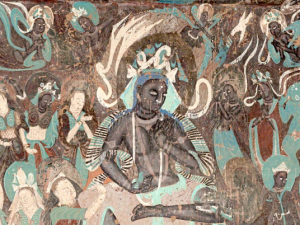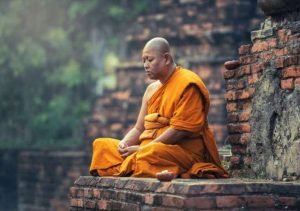
In June, I met about two dozen scholars, practitioners, and AI professionals at a conference in Taipei, as well as hundreds of people in the audience and online, to discuss the intersection and/or overlap of Buddhism and AI. The conference was envisioned and organized by Ven. Yifa and sponsored by the Woodenfish Foundation. One theme common to most of our presentations and conversations was “sentience.” As is well-known, the topic of sentience is fundamental to Buddhist theory and practice, which have direct implications for our conceptions of the potential, nature, and the destiny of insentient beings, sentient beings, and buddhas. According to some Mahāyāna Buddhist texts, insentient and sentient beings alike have buddha-nature and become buddhas.1
So where does AI fit into this ontology? The Korean movie Doomsday Book (Inryu myeongmang bogoseo) tries to explore this question. As intelligent as they are, LLMs (large language models such as ChatGPT) are insentient. Ven. Gotō, the originator of Mindar, the Kannon Bodhisattva in android form at Kōdai-ji in Kyoto, refers to Mindar as a “talking buddha statue” and insists that Mindar is not sentient. Similarly, in his Dharma talk, Mindar answers the question whether the selflessness of AI and of the Buddha are the same with a resounding “no.” My questions for today’s essay are: what is sentience?, what is buddha-mind?, and what are the criteria of these categories?
The central problem to consciousness studies and even everyday life can be formulated as follows: how can I recognize, verify, and know that both I and my conversation partner are self-conscious. The latter question is known as the problem of other minds. Both problems are rather befuddling. David Chalmers famously refers to the former question as the “hard problem.” Some Buddhist philosophers, however, venture an explanation of this conundrum. In his Twenty Verses (Viṃśatikā), Vasubandhu (fl. 4th–5th century) observes that “the unenlightened are not only unable to know the minds of others, but they also have no knowledge of the true nature of their own minds, whereas the enlightened know their own true minds and the true minds of others. Things known to enlightened ones are unknown to the unenlightened.”2 The self-conscious self knows and posits the world as an object and subsequently objectifies its own mind as well as the minds of others. However, self-consciousness is by nature subjective. Buddhas, on the other hand, know other minds in the same way that those minds know themselves. Buddhas, for example, know every one of us the way we know ourselves in addition to the way everyone and everything else knows us. The attainment of buddha-mind (Skt. bodhicitta) requires a fundamental transformation of consciousness. Dōgen (1200–1253) likens this transformation to the process of “forgetting the self.”3 If we want to “know” subjectivity as subjectivity, we have to let go of our cognitive habit of objectifying the world we experience and develop new cognitive habits, namely those of buddhas. Only then can we know the minds of others the way they experience their minds themselves.
Vasubandhu indicates this transformation in two basic ways. In his commentary on the Verses on Discrimination between Middle and the Extremes (Madhyānta-vibhāga-kārikā), he cites the words attributed to Asaṅga “under the appearance of things inanimate, living beings, self, and representation of consciousness, is born consciousness. There is nothing as its objects, and thus that objects being absent, consciousness, too, is non-existent.”4 To Vasubandhu, everyday consciousness (Skt. citta) is constituted in relationship to an object (Skt. caita). Subsequently, in self-knowledge, the knowing self posits the knowledge of itself as its object. Without such a posited object, everyday consciousness does not exist. In self-awareness, the knowing self does not objectify itself. The cognitive transformation necessary to attain “the mind of awakening” (Skt. bodhicitta) requires that the “objectified self” is, to use Dōgen’s words, “forgotten.”
As I discussed in an earlier essay,5 the Ten Ox Pictures (Shiniutu) of Kuoan Shiyuan (12th century) exemplify this transformation. The complete set of 10 pictures depicts the transformation from the “ignorance” (Skt. avidyā) of sentient beings to the “wisdom” (Skt. prajñā) and “compassion” (Skt. karuṇā) of bodhisattvas. In these pictures, the everyday consciousness of the practitioner is represented by a cow herder, the conceptions the practitioners have of themselves, as the ox. In picture seven, the ox disappears, in picture eight, the person disappears. The titles that Kuoan gave to those two pictures are, interestingly enough, “the ox is forgotten—the person is there” (Ch. wangniu youren) and “both, persons and ox, are forgotten” (Ch. renniu juwang), respectively. Bodhicitta, the mind of the buddhas, does not perceive the world as an object but they rather perceive everything, including all selves and all minds, “as they are” (Jp. nyoze jissō). (DZZ 1:267)
Vasubandhu formulates the doctrine of the “three self-natures” (Skt. tri-svabhāva) to highlight the way in which consciousness changes during this cognitive transformation. As is well known, the “three self-natures” are identified as “the imagined” (Skt. parikalpita), the “interdependent” (Skt. paratantra), and the “accomplished” (Skt. pariniṣpanna). In the first stage of this process, we perceive the world as object: we believe that the world is comprised of sense objects the way we perceive them. Sense perception, we think, constitutes the key to verifying and falsifying truth claims about reality. Vasubandhu calls the world of sense objects “the imagined.”
However, meditation as well as skeptical inquiry shows us that the appearance of sense objects depends on our senses and, more generally, the physiological processes that interpret our sense data as well as past experiences. If we possessed different sense organs and a different physiology, but also a different history constituted by different past experiences, we would most likely perceive the world differently. As the contemporary philosopher Thomas Nagel famously suggested, we do not know “what it is like to be a bat.”
For this reason, Vasubandhu claims that our knowledge of the world in general and our self in particular as objects “depends” on the existence of the subjective self. The “accomplished” bodhicitta, however, transcends this subject-object structure. The same three cognitive attitudes and stages are also expressed in the famous Chan/Zen aphorism that I discussed in an earlier essay: “Mountains are mountains, waters are waters . . . mountains are not mountains, waters are not waters . . . mountains are just mountains and waters are just waters.”8
This brings us back to the question how we can know our own mind or the minds of others. Buddhas know me the way I know myself, buddhas know you the way you know yourself, buddhas know others the way they know themselves. This means that bodhicitta does not objectify my mind and myself the way my everyday consciousness does, but also knows me the way I know myself and the way everyone and everything else knows me as well. This knowledge of the other as subject is called “intersubjectivity.”6 Dōgen uses the flexibility of Chinese grammar, where syntax is driven by the word order subject-predicate-object to describe this intersubjectivity as follows: “You attain me, I attain you, attaining you (is) me, attaining me (is) you.” If we were to apply the general syntactic structure common in Chinese subject-predicate-object, the second half of this sentence—“attaining-you-me, attaining-me-you” (Ch. deruwu dewuru, Jp. tokujogo tokugojo)—would read: “attaining you(s) me, attaining me(s) you. Be that as it may, independent of Dōgen’s creative and idiosyncratic use of Chinese, he makes the point that the intersubjective relationship between self and other transcends the subject-object structure of everyday consciousness. This is why and how a buddha can know me as a subject.

But how can we conceive of the multiple interactions between multiple sentient and insentient beings? On multiple occasions in his Shōbōgenzō, Dōgen adds a fourth dimension to the three mindsets discussed in this essay. These three mindsets are: (1) mind that objectifies the world; 2) mind that is aware that our experience of the world is dependent on the subject-object structure of conscious experience; 3) the bodhicitta that transcends the subject-object structure and experiences the world “as-it-is.” In 4) Dōgen explains: “Now, I and the other engage in liberative practices and enter into a teacher-student dialogue; he and an other engage in liberative practices and enter into a teacher-student dialogue. In me, there is expression and non-expression. In him, there is expression and non-expression. At the bottom of the way, there is self and other; at the bottom of the non-way, there is self and other.”8 The objectified mind, the subjective mind, and the intersubjective “mind-to-mind transmission” (Ch. yixin chuanxin, Jp. ishin denshin) constitute abstractions of what we can only call a multi-vector space of interactions by sentient and insentient beings. All of these interactions express one aspect of reality and obscure another.

In the introductory paragraph I asked how we can know the self. The methods that reveal to us these four mindsets introduced in the texts of the Chan/Zen Buddhist and discussed here, I have come to call third-person, first-person, second-person, and fourth-person approaches.9 A third-person approach is based on extrospection, analyzes the mind via input and output, and defines consciousness as intelligence; a first-person approach is based on introspection, analyzes the mind as subject-object structure, and defines consciousness as intentionality; a second-person approach is based on intersubjective engagement, analyzes the mind as I-Thou relationship, and defines consciousness as self-consciousness, emotion, and empathy; a fourth-person approach is based on embodied awareness of the environment, analyzes the mind within a multi-vector space of interactions, and defines consciousness as expression of “all buddhas and ancestors” vis-vis infinite other such expressions. (DZZ 1: 300)
All four approaches are important. They highlight various aspects of what it means to be conscious, to be a self, to be human. To know the mind of the self as well as the mind of the other, be it organic or inorganic, be it “natural” or “artificial,” we need to include and consult as many methods and perspectives as possible. Ideally, we would include or consult an infinite amount of these methods and perspectives. Then we would be able to know the mind of the Buddha.
1 Does Artificial Intelligence Have Buddha-nature? (BDG)
2 Vasubandhu 274-275
3 DZZ 1:7
4 Vasubandhu 237
5 Who am I – Self-discovery in Japanese Zen Practice (BDG)
6 Why I study Zen Philosophy (BDG)
7 T 2077.51.614
8 DZZ 1:302
9 Ghosts, Mummies, and Robots in Buddhism (BDG)
References
Ōkubo, Dōshū, ed. 1969–70. Dōgen zenji zenshū (Complete Works of Zen Master Dōgen). Two volumes. Ed. Tokyo: Chikuma Shobō. [Abbr. DZZ]
Takakusu, Junjirō and Kaigyoku Watanabe, eds. 1961. Taishō shinshū daizōkyō (The Taishō Edition of the Buddhist Canon). Tokyo: Taishō Shinshū Daizōkyō Kankōkai. [Abbr. T]
Vasubandhu. 1989. A Buddhist Doctrine of Experience: A New Translation and Interpretation of the Works of Vasubandhu the Yogacarin. Translated by Thomas A. Kochumuttom. Delhi: Motilal Barnasidass Publishers.
Related features from BDG
Beyond Binaries: Prof. Klaus-Dieter Mathes’ Non-Dual Legacy
Book Review: Steven Heine’s Dogen
Sino-Indian Narratives on the Transcendent: Chinese Philosophy Scholar Laura Lettere on the Buddhacarita
Consciousness, Attention, and Intelligent Technology: A Karmic Turning Point?
Self, No-Self, or Self
The Body’s Appearance Upon Rebirth in the Land of Bliss














